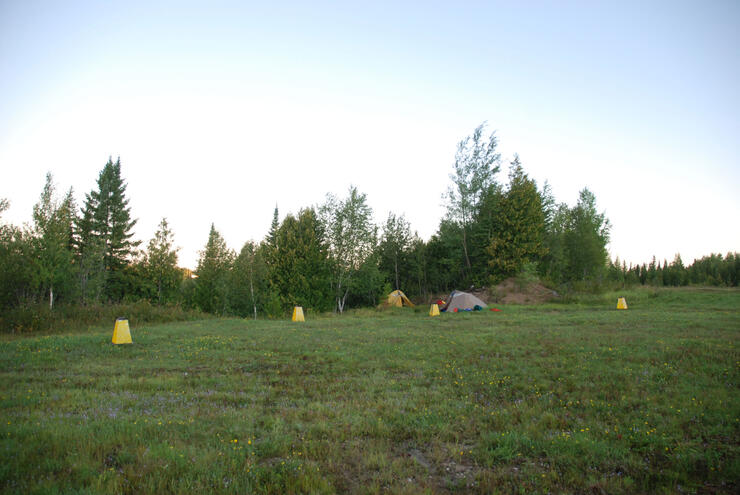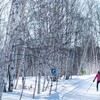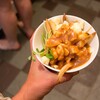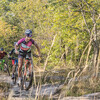
Why I (Temporarily) Traded in My Canoe For a Kayak

I jumped the gun a bit when the tourism gang from the Timmins region in Northeastern Ontario invited me up to participate in the Great Canadian Kayak Challenge. I agreed to race, basically because I love the Timmins area. Problem is, I’m a canoeist, not a kayaker. I also don’t have much of a competitive spirit. The last race I took part in was at a church picnic, when I was eight, running across a field balancing a hard-boiled egg on a spoon. I’m definitely not an anti-kayak sort like some of my canoemates, but to me, the joy of paddling is gently gliding a canoe across a mist-covered lake, not squeezing into tight neoprene and propelling myself across the water as fast as possible. But then again, I love the north, so there was no way I was going to pass up being there for such an event.
Of course, there was still the issue of not knowing how to kayak. For that I contacted an outfitter I knew from Smooth Rock Falls — Rick Isaacson of Howling Wolf Expeditions. His idea seemed simple enough. Rick would take me kayaking down the Abitibi River a few days before the race to teach me the techniques needed to finish the race with style and not come in last, or at least not look like a total geek when getting in and out of the boat.
To give myself more time practising out on the Abitibi River, I took a flight out of Toronto to the City of Timmins. The extra cost was well worth it since Rick picked me up at the airport and had us launching at the Abitibi Canyon Hydro Dam by mid-day.
Abitibi Canyon Dam was built in the early 1930s and once housed enough people to be considered a good-sized village, made up of seventy houses, a church, a school, a post office, and a place to buy groceries and alcohol. Lots of alcohol. It’s now a ghost town — a real ghost town. Two monuments are the basis for the alleged haunting. One is dedicated to at least four men who were encased in the concrete dam during the initial construction. (Rumour has it that the number is actually as high as two hundred.) It’s called “The Sons of Martha,” and has profound poetry inscribed on all four sides. A second marker pays homage to the ten hydro employees who died one foggy morning in 1976 after their plane crashed into the hydro tower 250 metres northwest of the dam. With such a high body count, the ghost stories have become legendary.
We drove over the wall of cement — one side holding back the Abitibi River, and the other revealing the deep canyon lined with a mix of cement and hard granite. Rick then turned down a secondary road to reach the access point downriver.

What an embarrassment! Getting in and out of a kayak without getting wet, and while retaining my dignity, seemed next to impossible. Rick, however, showed me a couple of manoeuvres to make the act look somewhat graceful. My preferred entry was sliding my butt across the paddle shaft anchored behind the seat and braced against the mud-caked shoreline of the Abitibi. It wasn’t until my third attempt that I slipped into the driver’s seat without mishap.

A pit stop was made at the old site of New Post fur trading post. Again, thankfully we had Rick as a guide. I would have definitely passed this area by. The only evidence of the site being a past homestead and trading post were patches of rose bushes and rhubarb peeking through clumps of aspen, birch, and wild raspberries. The spot was also flat, a rarity along the banks of the Abitibi. The Hudson’s Bay post was established around 1867 to encourage Indigenous trappers to trade there rather than go south to Timiskaming. It was placed at the end of a long portage around the rapids that existed before the construction of the dam. Boats travelling up from Moose Factory were swapped for canoes travelling downstream, and cargo was exchanged. A big white clapboard house was built for the Hudson’s Bay Company factor, along with an even larger store and two smaller buildings to accommodate the Cree trading at the post. When the railway was extended, it meant the end of New Post, and by 1924 it was abandoned.
Not much remained intact at New Post due to the dam causing fluctuating water levels that continually erode the riverbank. Rick took us farther back, through a large stand of mature poplar and stunted spruce, to view the gravesites. Here, a number of Hudson’s Bay workers and local Cree people are buried. Stone markers and wrought-iron fences marked the European graves, and cedar planks marked the Cree sites. Growing among them all were various species of flowers, introduced here via an elaborate garden once cared for behind the horse stable and dairy. It was a haunting place to be, and we paid homage to the people who lived — and died — here along the Abitibi before heading back to the river.
Our first night camp was upstream on New Post Creek, at the base of New Post Falls. We chose a sandbar, which Rick said would be fine to pitch a tent on as long as we broke camp before mid-morning. The waters of the Abitibi are completely controlled by hydro dams, and levels fluctuate each time cities like Toronto crave power. Rick and Luis obviously knew the river. Still, we were a tad late packing up, and our tent almost floated away on us.



Rick went over the main steering strokes, the first being the forward sweep. Again, it all had to do with the rotation of the torso. To make the kayak turn right, I would lean forward and place the left blade of the paddle up toward the front, by my feet, and then sweep the blade out in an arc until it reached the back of the kayak. I used the opposite manoeuvre to go left. The reverse back sweep was the reverse of the forward sweep, and by alternating the two I was able to spin the kayak in circles. Then there was the stern rudder and bow rudder, the cross-bow rudder, the hanging, standard, and sculling draw — all of which were somewhat similar to what I use to paddle a canoe. What wasn’t comparable was the tactic of leaning the kayak in one direction to move it in the other, which was absolutely critical for keeping the kayak in a continual forward motion but still in a straight line.


This is where the road ends in Northeastern Ontario. The railway continues on to Moosonee and back to Fraserdale, near Canyon Dam.
Onward, to the Great Canadian Kayak Challenge
Some paddlers doing this route will flag down the train for a ride back, but we drove to make it back in time for the big kayak race in Timmins — the Great Canadian Kayak Challenge. It’s a long drive, of course, and Rick and I arrived twenty minutes before the first heat of kayakers — titled the Celebrity Challenge — paddled off the starter line. I was one of the chosen “celebrities,” and quickly floated my kayak, still with Abitibi mud smeared along its hull, alongside the mayor, the police chief, the fire marshal, a couple of radio hosts, and an assortment of councillors.
It was an odd feeling to be a southern Ontario canoe guy turned kayaker for the week, trying to mingle with a bunch of local northern Ontario heroes who had been training for the race all season. I felt somewhat like a donkey put in the starting gate with Thoroughbreds.
Just as I started to blend in with everyone and feel a little less intimidated, the starter horn blew and off we went down the Mattagami River. It was like a game of bumper boats at first, with each kayak trying to push into the lead. In the panic I drifted off toward the right bank and separated myself from the crowd. From there I simply picked up the same paddling momentum I had out on the Abitibi, remembering the key instructions given me by Rick. I kept my blade low and propelled it from tip to hip, used my torso rather than my arms, and made sure to relax each and every stroke.
By doing so, I reached the turnaround point with a collection of good paddlers: the mayor, a councillor, and a Quebec radio host. We stayed together in a pack right up until the last few hundred metres. That’s when my lack of competitiveness failed me, and the others were able to get ahead. Except for the mayor. He was still deck to deck with me until just before the finish line. Then, rather than pushing myself to try and pass him, I placed my paddle down and yelled at the crowd, “Should I let the mayor win?” There were some laughs from the audience — together with some distasteful glares — followed by a media frenzy that had me promising on radio, and in print, to return to Timmins (and to my training grounds on the Abitibi River) to beat the mayor in next year’s Great Canadian Kayak Challenge.
It was a great few days spent in the north. I was able to paddle one of the most historic rivers in Ontario. Got a kayak lesson from Rick Isaacson of Howling Wolf Expeditions — and Rick won gold in his race, the master’s elite division. Way to go Rick! More importantly, however, a true-born canoeist like me was able to enter a world-class kayak race and not only come in sixth place, but also enter and exit the boat without looking like a complete idiot.
Recommended Articles
The Seven's Best Hikes, Biking Trails and Lakes

7 Best Spots to Check Out in The Seven

Budget Bliss: Explore Northeastern Ontario Without Breaking the Bank

Bring Your Fam!

Time to Unwind: 6 Spa Havens to Discover In The Seven
5 Amazing Places to SUP in Northeastern Ontario

5 Amazing Bike Rides to Discover

Northern Lights in Northeastern Ontario

Northeastern Ontario's Best Pride Festivals

Fish for one of the World's Rarest Species of Trout

An Insider's Guide to Manitoulin Island

6 Small-Town Gems to Explore in Northeastern Ontario

11 Best Things to Do in Kapuskasing, Ontario



























